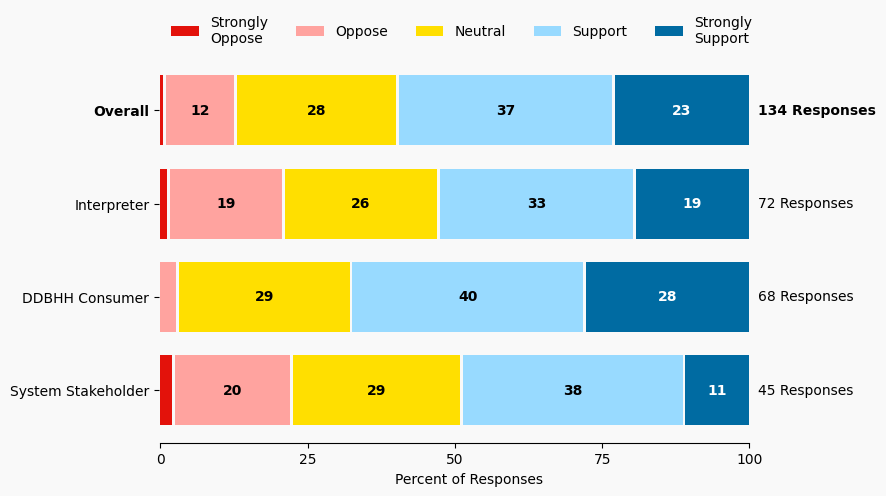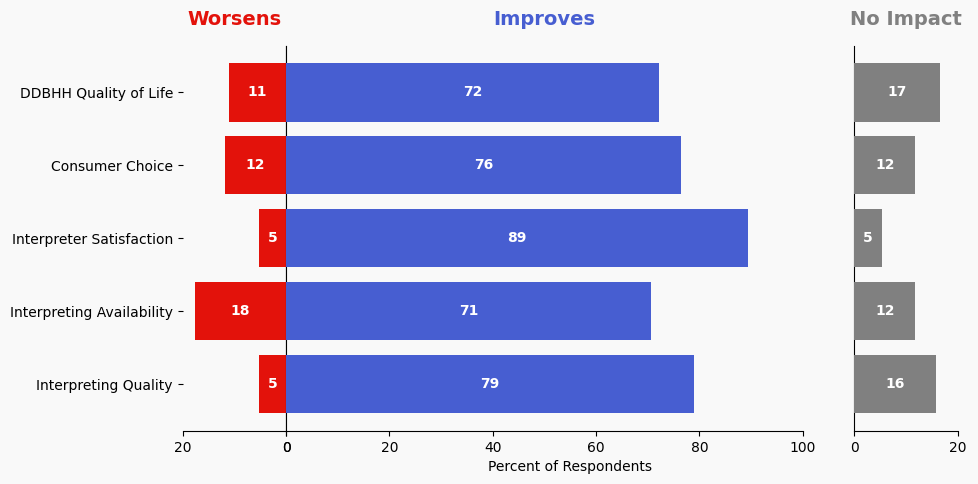12 Support Business Development by Developing a Public State Payscale for Freelancers
Issue: There is no clear or consistent payscale for freelance interpreters.
Proposed Solution: Some states have published pay scales for interpreters working with state agencies. A published pay scale is a general guide, not a mandatory business practice; it can guide hiring entities and give working interpreters a guide of reasonable compensation rates. A new task force could develop a payscale for interpreters, based on experience, education, specializations and other qualifications.
Expected outcome: Transparency with some guidelines for compensation may lead to interpreters receiving higher pay. Understanding compensation possible with some specializations may entice interpreters to become proficient in new areas.
Who is impacted: Student interpreters, new interpreters, experienced interpreters
Timeline: 6 months

Summary of Support Image Description
The stacked bar charts show how respondents rated their level of support and the total number of responses. The percentage for the five support levels is shown from left to right: Strongly Oppose (Dark Red), Oppose (Light Red), Neutral (Yellow), Support (Light Blue), and Strongly Support (Dark Blue).
Respondents may identify with multiple subgroups. The overall level of support is:
Overall
Strongly Oppose: 1%
Oppose: 12%
Neutral: 28%
Support: 37%
Strongly Support: 23%
Click to see the detailed image description for each subgroup.
Interpreter
Strongly Oppose: 1%
Oppose: 19%
Neutral: 26%
Support: 33%
Strongly Support: 19%
DDBHH Consumer
Strongly Oppose: 0%
Oppose: 3%
Neutral: 28%
Support: 40%
Strongly Support: 28%
System Stakeholder
Strongly Oppose: 2%
Oppose: 20%
Neutral: 28%
Support: 38%
Strongly Support: 11%
Overview of Respondents Opting for In-Depth Solution Analysis
After indicating their support level, 14% of the 134 respondents opted in to further assess whether the solution would worsen or improve on five metrics. Of the opt-in reviewers (19 respondents), 57% supported the solution, 21% were neutral on the solution, and 21% opposed the solution.
The remaining 115 respondents did not opt in to further assess the solution. Of these people, 60% support the solution, 28% were neutral on the solution, and 11% opposed the solution.
Reviewer Evaluation of Solution Effectiveness

Solution Effectiveness Image Description
The stacked bar charts show how respondents assessed the effectiveness of this solution based on five metrics. For each metric, the percentage of respondents is shown from left to right: Worsens (Red), Improves (Blue), No Impact (Gray).
DDBHH Quality of Life
Makes It Worse 11%
Makes It Better 72%
No Impact 16%
Interpreter Satisfaction
Makes It Worse 5%
Makes It Better 89%
No Impact 5%
Consumer Choice
Makes It Worse 11%
Makes It Better 76%
No Impact 11%
Interpreting Availability
Makes It Worse 17%
Makes It Better 70%
No Impact 11%
Interpreting Quality
Makes It Worse 5%
Makes It Better 78%
No Impact 15%
Reviewer Feedback and Insights
Interpreter
Comments from Interpreters express mixed feelings about the feasibility of a public payscale, given their status as self-employed entities. One comment believes the current system, where referral agencies set the terms, needs reform and suggests a panel of experts to evaluate qualifications and specializations to determine pay tiers. Another comment express openness to the idea but note the complexity of implementation.
Deaf, DeafBlind, Hard of Hearing
Comments from DDBHH Consumers highlight the inconsistency in interpreter pay and express desire for greater awareness within the deaf community regarding such initiatives. One comment emphasize the need for licensing before considering a public payscale. Another comment stresses the importance of including DDBHH voices in the process.
System Stakeholder
Comments from System stakeholders suggest that a group of experts should evaluate specializations to fit interpreters into appropriate pay tiers, considering the varying qualifications of interpreters. One comment is raised about how credentials align with community needs and the potential for overlap between a public payscale and market demands.
PREVIOUS SOLUTION
11 Complete Studies about DDBHH Communities and Interpreting Field
Issue: Insufficient demographic information about DDBHH Minnesotans.
NEXT SOLUTION
13 Require All Major Local News Services to Provide Picture-in-Picture Interpreters
Issue: DDBHH Minnesotans do not all have clear access to news in the local communities where they live.
Leave a Reply